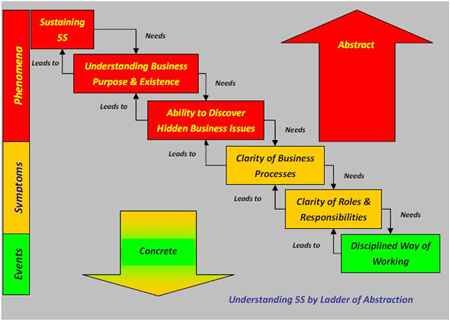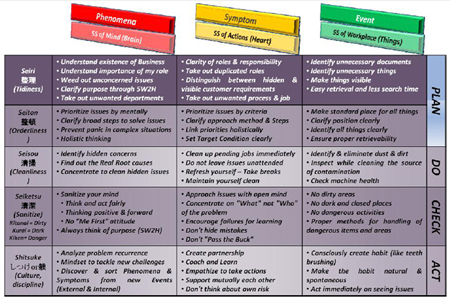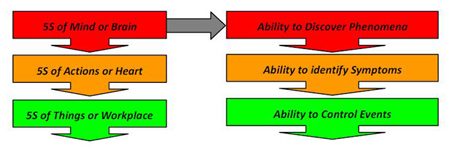Sustaining Results: Why You Should Apply "5S" to the Way You Think
Add bookmarkSimply implementing the Lean principles of 5S is like running a race, says contributor Subikash Roy. After the race, you win a medal and celebrate, and then, everything is forgotten. So how do you sustain the results after initial implementation? One of the first places to start is by applying 5S to yourself, argues Roy.
The Lean principles of 5S is based on the idea that organizing and standardizing the workplace makes it a more efficient place to work through benefits such as making the tools workers need easy to find and eliminating excess inventory. 5S itself stands for sorting, straightening, systematic cleaning, sanitizing, and sustaining.
But 5S is more than a tool or a method. We must first understand that 5S is a culture. Simply implementing 5S is just like running a race. After the race, you win a medal and celebrate, and then, everything is forgotten. So we must understand that we are not running a race.
That starts with top. Senior management must decide how they want people to act and then visibly demonstrate through their own behaviour the way they want employees to act. Next is to set up a way of teaching and coaching employees to embed a way of thinking and acting, and finally, management give those behaviours due priority.
This is more difficult than it sounds. When the pressures on to delivery quarterly (or whatever time denomination you work in) targets, will management force staff to circumvent established ways of working to just get the job done? This is reactive rather than proactive behaviour and is the type of "firefighting" behaviour that we need to change because it sends a message to employees that when the chips are down management is not really serious about this "continuous improvement business."
So what are the levers you need to control to help this shift to a 5S mindset? We need to move beyond applying 5S just to tools and look at how it applies to our behaviours and approaches. But before we explore that further, I’d like to introduce a different a different lens through which to understand 5S: that of Phenomena, Symptoms and Events.
Understanding 5S through Phenomena, Symptoms and Events
What are Phenomena? Phenomena are the hidden or invisible factors or issues - both external and internal - which plague all businesses. For instance, it could be a technological change or a competitive threat that’s emerging outside of our individual business. It could also be failure to adequately monitor and account for risk, as in the case of the subprime mortgage debacle which brought an entire financial services industry to its knees.
In the terminology of Donald Rumsfeld, phenomena are like the "unknown unknowns" - those things we don't know that we don't yet know - that can and will fundamentally affect the performance of our businesses and it is the role of the executive team to try to anticipate and understand what those phenomena are before it’s too late. An executive's job is find the unknown unknowns and take steps to address them.
The way we’re alerted to the existence of phenomena is through their associated symptoms. Symptoms are the visible - and sometimes invisible – signals that not all is right with our business. For instance, we may find that our customer base is eroding (a symptom). But delving further and understanding why our customer base is eroding leads us into the phenomena. By analysing all contributing symptoms, managers will find out real Root Causes (Phenomena) and correct them to prevent further recurrence.
The final layer in this trilogy are the events. Events are visible real world happenings. An event, for instance, may be a specific customer phoning to cancel an order. If we only focus on the visible events within our companies without understanding why they’re happening, we’ll be like the proverbial dog chasing his tail.
I believe that sometimes when implementing 5S we become a little like this dog. We focus on the visible effects forgetting about the underlying cause. Or to take another metaphor, we apply medicine to relieve the symptoms without resolving the underlying disease. For instance, I may take an aspirin to relieve the effects of a stomach ache that periodically recurs. But eventually the pain may get so great that I end up going to the doctor who tells me it's a critical condition like cancer and I've arrived too late. Our senior management needs to be focused on diagnosing these conditions before they become so critical!
The figure below describes the interaction between each of these different characteristics.
In my experience, I’ve often seen top and senior management become engrossed in implementing 5S or other tools. This is not the best use of their time – instead top management should be focussed on understanding the business purpose and its existence; and their ability to discover hidden issues that could affect the organization negatively in future and in the longer run for survival.
Thus, to better anticipate phenomena, predict symptoms, and therefore, control events leads us to categorize 5S into 3 categories:
1. 5S of the Mind (Brain)
2. 5S of Actions (Heart)
3. 5S of Workplace (Physical Things)
The table below summarizes the characteristics of each of the categories:
5S of the Mind
What is 5S of the Mind? Simply put, it is a holistic, mental PDCA. By changing the way we think about the business, we improve ourselves and thus inculcate a positive shift in culture in the organization. This is the beginning of leading change in the organization.
What does that look like? We must first be clear about the purpose of our business and our roles and responsibilities. We must be able to sort out the necessary from the unnecessary issues of our business. This is called Seiri or sorting of the mind.
Straightening (Seiton) or Orderliness is to be able to prioritize issues mentally – to get it "straight" in your own head. It is this image in our mind that helps us identify symptoms and clarify broad steps to solutions and to avoid panicked reactiveness to new situations.
Systematic cleaning (Seisou) is the constant cleaning of the mind by identifying hidden concerns and finding the real root causes. Concentrate to understand the real root causes of hidden issues.
Santize (Seiketsu) is to clear your mind constantly to think and act fairly and positively so as to always keep moving forward. As leaders, we must be able to think and act above selfish and vested interests; we also must strive to make decisions in a consistent manner.
Sustaining (Shitsuke) is the maintenance of culture or discipline through analysis of recurrences. Shitsuke also helps us to generate the mindset to tackle new challenges by discovering phenomena and symptoms from events around us.
5S of Actions
5S of actions is to develop the capability to act logically and with a direction. All actions that are derived from 5S of the mind must be converted into actions. Clarity of our roles and responsibilities and sorting and eliminating duplicated responsibilities is the initiation of Seiri of Actions or Heart. This will help us eliminate the unwanted jobs and processes and thus improve our capabilities to visualize the latent customer requirements.
By prioritizing issues by criteria of customer requirements and linking them holistically to provide a systemic approach and method to set target conditions and solve problems, we have begun the Seiton of the heart.
Once we prioritize we must ensure that we clean up any pending jobs immediately and continuously without procrastination. Maintaining ourselves both physically and mentally and taking occasional breaks from monotony will enable us to perform Seisou effectively.
Once we have effectively mastered the 5S of the heart, we must consciously approach issues with an open mind to concentrate on the "What" and not the "Who" of the problem. Seiketsu encourages failures as treasures for learning and improvement.
Shitsuke creates partnership and mutual support of each other in the organization, and synchronizes the behavior with skills and knowledge. As management executives we learn to empathize with our people and get involved in their problem as if it were ours.
5S of the Workplace
We have all been doing the 5S of the physical environment of our workplaces for decades now and therefore I’m not going to elaborate on this - but do remember that 5S of things cannot sustain unless the above two 5S are properly embedded in the organization as illustrated in the figure 3 below.
The Power of 5S
5S helps us initiate the real change in our organizations by finding real root causes; be it through the methods of Lean, Six Sigma, TPM or TQM etc. It’s not just a technique to be applied to "things" within our businesses – it is a tool to sharpen the way that we think about and approach the challenges that confront every business.
It’s only once we understand – and train our employees to understand – that 5S is a not just a technique but a behaviour that we will be able to sustain the results of 5S. Otherwise we can keep doing 5S "events" forever and not derive the true benefits of it.
[eventPDF]























